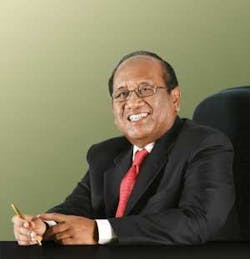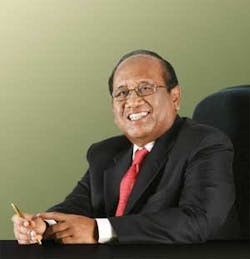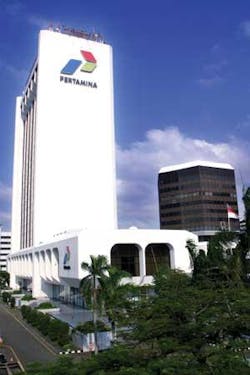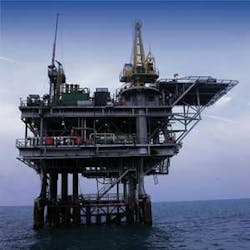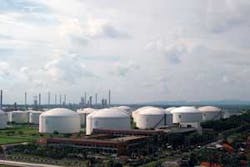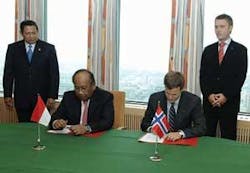Transforming Pertamina into a competitive powerhouse
AN INTERVIEW WITH ARI SOEMARNO
EDITOR’S NOTE: The following interview with Ari Soemarno, president and CEO of Pertamina, the state oil company of Indonesia, was conducted by the editorial staff of Focus Reports exclusively for Oil & Gas Financial Journal. Soemarno, a veteran of 30 years with Pertamina, accepted his new role in 2006 on the condition that he be allowed to transform the company from what was essentially a regulatory role on behalf of the Indonesian government to a more efficient and competitive oil and gas company that would operate under a market-based system.
QUESTION: As Pertamina prepares to celebrate its 50th birthday this month, it finds itself at a crucial turning point. While other national oil companies around the world have been growing aggressively and capitalizing on the price boom of the last several years, Pertamina has been dedicated to restructuring and forging a new identity. Is it finally ready to project itself towards the future?
ARI SOEMARNO:Pertamina is ready to move towards the future. Our first 50 years were full of turbulence that was not related to business, but rather to political and economic crises. The company has evolved a lot since its creation by a small group of generals in 1957, going on to become the national oil company in the 1960s. Unfortunately, due to political intervention, Pertamina’s evolution was not very business-oriented. It basically became regulator and supervisor of the oil and gas industry on behalf of the Indonesian government.
Pertamina’s next 50 years are going to be very different. Following its transformation into a limited liability company in 2003, the regulatory and supervisory functions have been handed over to the Ministry of Energy, and entities like BP Migas (upstream) and BPH Migas (downstream) were created. Currently in upstream we have to compete for contracts, and in downstream there is no longer a monopoly. Pertamina can now be considered an integrated oil and gas company, like all the others.
QUESTION: How much progress has been made towards transforming Pertamina into a more competitive and efficient company over the last several years?
SOEMARNO: Due to pending regulations after the legal change of status in 2003, it was not until 2006 that the transformation process was concluded. During that time, Pertamina was in a transitional period, still carrying out activities on behalf of the government. In upstream the changes were made official in 2005, but for downstream the transformation did not take place until early 2006, when the government agreed to adopt a market-based system for the distribution of fuel.
I took office in early 2006 just as the transition was officially finalized. When I was asked to assume the position of president and CEO of Pertamina, my condition was that I wanted to transform the company. I said that I would only be ready to take the position if the shareholders (the Indonesian government) were on this same line of thought. Their response was clear: to move ahead. In May 2006, President Yudhoyono himself confirmed this and stressed Pertamina’s importance for Indonesia and the need to carry out the necessary changes successfully.
QUESTION: The new Pertamina you are shaping receives a considerable inheritance from the former Pertamina. Do you see it more as an asset or liability for your future development?
SOEMARNO: Of course the physical infrastructure and knowledge of the Indonesian territory are valuable assets inherited from the former Pertamina. But as for the “software” of the company, I see it more as a liability. Our foremost challenge today is to modify the culture, mindset, and management style that are all an inheritance of the past. We have to adapt the whole company to a new situation where we have to think about marketing, make profits, be competitive and efficient, etc.
QUESTION: How are you encouraging a change of mindset and management style in a company that has thousands of employees and such an embedded culture?
SOEMARNO: Pertamina currently employs more than 18,000 people. In order to move forward this transformation on such a large scale, we are working with consultants on formulating and implementing a two-part program. The first aspect and main emphasis of the program has to do with the fundamental change of the employees’ mindset and culture, as well as the management and leadership style. This is being done through various initiatives, consisting primarily of a personal approach where discussions are held with each of our employees. The second aspect is related to the changes in the business structure, according to Pertamina’s new role in upstream and downstream activities.
In addition to changing the way we see ourselves, Pertamina is working to improve its image among the general population. We want to change people’s perception of the company, which has often been associated with corruption, nepotism, collusion, and dishonesty. The first steps to improve our image have been made through marketing campaigns, and most importantly, the restructuring of our retail fuel stations. This is where Pertamina has the most direct contact with customers and also a market where we are facing competition for the first time. Over the last year, great progress has been made in the revamping of our stations in terms of quality, customer service, and facilities. The public is already taking notice and gradually changing their perception of Pertamina.
QUESTION: Although Pertamina remains a state-owned company, it wishes to move away from its government roots in order to fully become a business-oriented commercial company. How far along is Pertamina on this path?
SOEMARNO: My goal is to transform this company into a true business entity. The board of directors and I believe that we should aim to prepare Pertamina to go public sometime in the future. We want to have a company that is ready and able to operate like a publicly traded company by 2009, with all the required transparency and financial reporting. Ultimately, of course, it is the shareholders’ decision whether or not to make Pertamina public. It is a politically sensitive issue, but there are examples of successful national oil companies (NOCs) like Statoil and Petrobras from which we can learn.
QUESTION: Many say that the high dividend that Pertamina pays out to the government (45%) is hindering its ability to allocate more of its profits to funding exploration activities. Will Pertamina be able to reinvest a greater part of its profits in the future?
SOEMARNO: This is a very crucial issue for the company, and I am personally involved in finding a good solution for both Pertamina and the government. This company is already contributing to the public finances through non-tax revenues, which come from the split agreed in the PSC between us as an upstream contractor and the government. Then we also generate revenue for the state by paying the 30% corporate tax. If, on top of all this, Pertamina has to continue paying such a high dividend, our capacity to grow is seriously compromised. While our neighbor, Petronas (the Malaysian NOC), can invest $5 billion to $6 billion per year thanks to the fact that they do not pay dividends or other non-tax revenues, Pertamina has a hard time just trying to reach a level of $2 billion.
I hope to bring our current dividend of 45% down to 30%, although ideally of course it would be closer to 0%. Two years ago, the company was distributing about $1.2 billion to the government in dividends. This went down to about $900 million this year, and recently we managed to avoid an increase for next year’s dividend. This makes me optimistic that now there is at least a growing awareness about the issue. Despite Pertamina’s progress, we still have low levels of production compared to other NOCs and therefore need the financial muscle to invest.
QUESTION: How are the current record-high oil prices affecting Pertamina’s short- and long-term investment decisions?
SOEMARNO: These market conditions only give Pertamina more incentives to step up investment. In our older fields, high prices mean that we can continue investing even in fields with elevated exploration and production costs. We are trying to grow aggressively, although the government urges us to move with caution. For this reason, Pertamina is not embarking on this growth alone and is establishing strategic partnerships in specific areas like deep water, where most agree lies the future of E&P in Indonesia. Because offshore has not been our expertise in the past, our company has a lot to learn and understand about these activities before becoming a true operator. In this regard we already have an agreement with Shell related to deep sea, a joint venture with Statoil, and are looking into deep-sea ventures with Petrobras.
QUESTION: What are the rationale and scope of announced plans to sell “non-core” business in 2008?
SOEMARNO: The focus will be on Pertamina’s core business lines, which are exploration, production, refining, and petrochemicals. We are already separating the subsidiaries that support our core activities from the non-core activities. For example, our drilling subsidiary is being consolidated into one basket with our upstream division. However, we have made a strategic decision to maintain certain non-core activities with high growth potential, such as geothermal. Although this is a completely different ballgame because geothermal implies getting into the electricity business, which is not our core. Still, Pertamina sees a high growth potential to apply our O&G drilling expertise. Regarding the rest of our subsidiaries, such as an airline, hotel, and hospital, they will be farmed out or completely divested in 2008.
QUESTION: Indonesia has seen declining oil production and reserves over the last several years, turning it into net importer of oil. This has many even questioning its place within OPEC. To what extent can Pertamina contribute to getting Indonesia back on the map of major oil-producing countries?
SOEMARNO: Pertamina has significant potential to be at the forefront of increased production thanks to the huge areas we operate in the country. Although they are mostly old production blocks, many are still prospective as a result of new exploration and production technologies. ExxonMobil’s massive discovery at Cepu field, which had been explored unsuccessfully since the time of the Dutch, is a prime example of how drilling techniques have advanced to give new life to old areas. On the production side, experts are now talking about recovery rates of 60% or even higher with the application of EOR technologies. In order to optimize production in these aging fields, we are working with partners like Shell and Statoil on secondary recovery phases.
Regarding new areas, Pertamina requests priority from the government during block tenders. In this way, they can support our development as the NOC and allow us to become the ideal partner in Indonesia for international companies. The big IOCs have an interest in doing business with Pertamina because we know the country and are familiar with the working environment, and in return we receive their technical knowledge and expertise. The main objective of all this cooperation is to create synergies which contribute to our aim of doubling production over the next five years. It is an ambitious target, but we have concrete plans in mind and are optimistic that they are achievable.
QUESTION: As you just mentioned, the plans for crude oil production are to nearly double from the current estimates of 155,000 bpd in 2007 to about 290,000 bpd in 2012. What is the E&P strategy that will make these ambitious numbers a reality?
SOEMARNO: Pertamina is participating in tenders and making the most of our old data on blocks in Indonesia to assess the most prospective areas. The company is also growing through a strategy of acquiring existing blocks. From our perspective, as long as a field is profitable it should be contributing to the country’s production, therefore when a big oil company sees that a field does not have the potential they expected or is not as profitable when compared to other assets they have elsewhere, Pertamina offers to acquire and develop it. Moreover, Pertamina is asking the government to give us right of first refusal for PSCs reaching the extension phase. All of this is part of our plan to grow our production and reserves aggressively over the coming years.
Contrary to what many might believe, our main constraint towards the future is not our financial capacity. The main concern is actually related to our ability to find and maintain the human resources required for Pertamina’s development. Upstream companies everywhere are facing a challenging moment right now due to high levels of employee turnover. Indonesian engineers are very sought-after by companies in the Middle East and other better-paying countries like Malaysia.
QUESTION: How are you facing the challenge of trying to keep your human resources from going elsewhere?
SOEMARNO: Pertamina has to offer competitive packages and become a more attractive place to work. We are increasing our salaries, but there is still a long way to go before Pertamina is at the same level of other NOCs and IOCs. A significant restructuring of the remuneration system, which allows us to determine sector-specific salaries within the company, is already in process. New recruits are also being hired, and Pertamina’s recent opening for 400 new engineer positions has received an encouraging response. The company offers them a good package and the possibility of doing a part of their training abroad.
QUESTION: When we interviewed Tan Sri Hassan Marican of Petronas, he told us that 50% of his company’s reserves and production will be located abroad in the near future. Where does Pertamina currently stand with regards to its own internationalization? What are the strategies and ambitions for overseas upstream activities towards the future?
SOEMARNO: Our first overseas operation was actually a concession in Iraq. Although it is not operational for the time being, the block is still there and we are waiting to see how the situation evolves. In the short term, Pertamina will not yet have a significant part of its production and reserves abroad. Some production is coming online from the off-shore field in Malaysia starting in 2008, which should reach a peak of about 20,000 bpd in 2010.
Beyond that, the real growth from our overseas activities will likely happen over the coming 10 years. We have several blocks abroad that are in the exploration phase. For example, in Libya, where we are in the process of doing seismic activities. The offshore block there in particular looks very prospective. In addition, Pertamina recently acquired a 25% stake in a new block in Qatar. The company is also looking into opportunities in South America, in Ecuador and Venezuela, but in these areas we will advance with caution. There are also offers in the Turkish Black Sea and Yemen, as well as the possibility of swapping areas with Lukoil in Russia.
QUESTION: Pertamina is very dynamic in establishing strategic alliances with both foreign and domestic partners. How is Pertamina choosing which kind of companies to partner with? What are the main areas of cooperation?
SOEMARNO: Pertamina has a certain interest in working with other NOCs, but the company is also pursuing opportunities with many of the major IOCs. For example, we are developing CBM with Shell in South Sumatra and are in talks with BP on downstream opportunities. We have no preference for NOCs or IOCs. Pertamina will cooperate with those companies willing to share their skills and expertise with us.
QUESTION: Indonesia is one of the top LNG exporters in the world, and with many energy-hungry countries growing at a rapid rate, the potential for further LNG development is still high. What are Pertamina’s main projects and future plans for LNG?
SOEMARNO: I started my career 30 years ago at an LNG plant, when Pertamina was a global LNG pioneer. I worked in several areas ranging from operations to project development, so I know the sector well. Basically, the future LNG potential will depend on the availability of reserves. Contrary to what many believe, LNG is interesting for Indonesia not only for export, but also for the domestic market. Indonesia is a vast archipelago, very difficult to connect, which makes current costs of LNG no more expensive than building pipelines for the domestic market. Indonesia already has LNG plants and the proper transportation ships available, therefore the only element missing is a receiving terminal in Java.
Pertamina is redefining its role in LNG development in Indonesia. Under the previous system, the company was assigned to handle all of the oil and gas related business on the government’s behalf, including LNG. Pertamina even co-financed the construction of LNG plants together with the contractors in order to encourage their investment in the sector. We will not take on the same kinds of liabilities in the future for the government, unless of course the gas reserves are allocated to us. On the other hand, Pertamina currently has an LNG project in Sulawesi under a completely different system. It is a downstream scheme, where the LNG plant is owned by the investor who has a guaranteed internal rate of return. The upstream counterpart sells the gas to the downstream company at a price which is tied to that of LNG. I believe that this could be a model for future projects.
Regarding natural gas for the domestic market, there is much room for growth but the government and buyers have to change the perception that gas is cheap. If they do not offer competitive prices to producers, there will be little incentive to develop gas for the Indonesian market. Furthermore, local governments with great gas potential, such as East Kalimantan, are not keen on supplying gas for domestic market because they fear their hefty export revenues would dwindle.
QUESTION: Indonesia is importing about a third of its oil needs because refining capacity has not been able to keep up with growing demand, and this in the midst of record-high oil prices. What plans does Pertamina have in order to expand and upgrade its existing refineries? What kind of partnerships is Pertamina looking for in refining projects?
SOEMARNO: Indonesia is currently importing about 35% of our requirements (mostly in the form of gas oil and gasoline) from the Middle East, Singapore, and Korea. This is because Pertamina has only about 1 million bpd refining capacity spread all around Indonesia, which is not enough to cover total demand. Since most of the big refineries were built in the 1980s or earlier, they are low on complexity and secondary processing. Balongan, the newest refinery built in the ‘90s, is the most economical and produces high-value commercial products. Other refineries’ output is basically limited to liquid fuel, kerosene, and gas oil.
Pertamina is working to make its refineries competitive. There are plans to revamp our biggest refineries, like for example the Cilacap refinery which has a capacity of 350,000, in a partnership with Mitsui. In addition, our Balikpapan facilities will be completely transformed to refine sour crude. Through a joint venture with SK we are also modifying our Dumai refinery, which will allow us to increase capacity and further consolidate our position in the Asian lubricant market.
On the new refineries, there are things in process but Pertamina is still working on fixing out the details with potential partners. In Southeast Asia there will be insufficient supply of all oil products for the foreseeable future, but the Middle East and India are building refineries for export capability. This means that refinery margins will remain on the low side in the future, but we are still interested in expanding our capacity and believe that there are interesting opportunities for investors. Over the coming years, our focus will be on revamping existing refineries first, but afterwards new facilities may be developed if the situation is conducive and the government offers good incentives.
QUESTION: Despite its turbulent past, Pertamina became one of Indonesia’s best known companies locally and also around the world. What role is the new Pertamina set to play in the development of the country and its oil and gas industry? Where do you want to take Pertamina over the coming years?
SOEMARNO: In the past, Pertamina was considered to be a powerhouse. And it was, but in the wrong sense. It was misused by many people, and the company was not able to grow. Whereas a younger company like Petronas which was originally even inspired by our model has come such a long way in its business and role as an NOC, Pertamina is practically still in the same position as 1974.
The next Pertamina cannot afford to make those same mistakes. This is why we have developed a road map for the next 15 years, with definite plans for the next five. During this first year and a half under my direction, we have been dedicated to creating solid foundations for the new Pertamina. Now the company is starting to move forward, with ambitions and clear objectives for the years to come. We are training a new generation of leaders who will become our transformation engine. Pertamina will become a powerhouse again, but now it will also be appreciated and respected by the public, shareholders and the international community. We want to be a role model in Indonesia: clean, competitive, and customer focused. That will be the Pertamina of the future.
null
